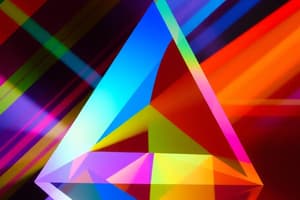Podcast
Questions and Answers
What effect does reflecting a square across a line passing through its center have on the square's dimensions?
What effect does reflecting a square across a line passing through its center have on the square's dimensions?
- It doubles the dimensions of the square.
- It reduces the dimensions by half.
- It creates a square with different proportions.
- It preserves the dimensions of the square. (correct)
What happens to the angles of a rectangle when it is reflected across a line parallel to one of its sides?
What happens to the angles of a rectangle when it is reflected across a line parallel to one of its sides?
- The angles become obtuse.
- The angles remain unchanged. (correct)
- The angles are inverted.
- The angles become acute.
When a point is reflected across a line, how does the line segment connecting the original point and its reflected point relate to the line of reflection?
When a point is reflected across a line, how does the line segment connecting the original point and its reflected point relate to the line of reflection?
- It intersects the line of reflection at an angle.
- It forms a parallel line to the line of reflection.
- It remains unchanged in length.
- It is perpendicular to the line of reflection and bisected by it. (correct)
What geometric property is maintained in the reflected image of a figure compared to the original figure?
What geometric property is maintained in the reflected image of a figure compared to the original figure?
In the context of congruence, how does reflection impact geometric figures?
In the context of congruence, how does reflection impact geometric figures?
What happens to the shape and size of a figure after it undergoes reflection?
What happens to the shape and size of a figure after it undergoes reflection?
What is true about points that lie on the axis of reflection?
What is true about points that lie on the axis of reflection?
In reflecting a point across a line, what is the relationship between the point and its reflection?
In reflecting a point across a line, what is the relationship between the point and its reflection?
How does the reflection of a polygon differ from the original polygon?
How does the reflection of a polygon differ from the original polygon?
How can one determine the coordinates of a point after reflection across the x-axis?
How can one determine the coordinates of a point after reflection across the x-axis?
What would be the coordinates of the point (2, 3) after reflecting across the y-axis?
What would be the coordinates of the point (2, 3) after reflecting across the y-axis?
What principle allows you to find the coordinates of a reflected point given the coordinates of a point and a line?
What principle allows you to find the coordinates of a reflected point given the coordinates of a point and a line?
What is a key characteristic of the axis of reflection in relation to a point and its reflection?
What is a key characteristic of the axis of reflection in relation to a point and its reflection?
Flashcards
Reflection (in geometry)
Reflection (in geometry)
A transformation that flips a figure over a line, called the axis of reflection.
Axis of reflection
Axis of reflection
The line over which a figure is flipped during a reflection.
Reflection properties: Shape & Size
Reflection properties: Shape & Size
Reflection preserves the shape and size of a figure. The reflected figure is congruent to the original.
Reflection properties: Orientation
Reflection properties: Orientation
Reflection changes the orientation of a figure. It flips the figure.
Signup and view all the flashcards
Points on the axis
Points on the axis
Points on the axis of reflection remain unchanged after reflection.
Signup and view all the flashcards
Points off the axis
Points off the axis
Points not on the axis of reflection are equidistant from the axis and its reflection.
Signup and view all the flashcards
Reflection x-axis: (x,y)
Reflection x-axis: (x,y)
Reflecting a point (x, y) over the x-axis yields (x, -y).
Signup and view all the flashcards
Reflection over y-axis: (x,y)
Reflection over y-axis: (x,y)
Reflecting a point (x,y) over the y-axis gives (-x, y).
Signup and view all the flashcards
Reflection across y-axis
Reflection across y-axis
Changes the sign of the x-coordinate.
Signup and view all the flashcards
Reflection through center of square
Reflection through center of square
Reflected square coincides with original.
Signup and view all the flashcards
Reflection and corresponding angles (rectangle)
Reflection and corresponding angles (rectangle)
Corresponding angles stay the same.
Signup and view all the flashcards
Original point & reflected point (line segment)
Original point & reflected point (line segment)
The segment connecting original and reflected point is perpendicular to the line of reflection, and the reflection line bisects the segment.
Signup and view all the flashcards
Reflection and Congruence
Reflection and Congruence
Reflection creates congruent figures. Same shape and size.
Signup and view all the flashcardsStudy Notes
Introduction to Mirror Images and Mathematical Properties
- Mirror images, or reflections, are transformations that flip a figure over a line. This line is known as the axis of reflection.
- Key mathematical properties arise from this transformation relating original figures and their reflections.
Properties of Reflection
- Reflection preserves shape and size. A figure and its reflection have congruent shapes and the same dimensions (length, width, height etc.).
- Reflection changes orientation. The reflection of a figure is a flipped version of the original, not just a rotated copy.
- Points on the axis of reflection remain unchanged. The coordinates of points lying on the axis of reflection stay the same after a reflection.
- For points not on the axis of reflection, reflection establishes a relationship between the point and its reflection. The point and its reflection are equidistant from the axis of reflection. The axis of reflection is the perpendicular bisector of the segment connecting a point and its reflection.
Questions Focusing on Reflection Properties
-
Question 1: Describe the relationship between a point and its reflection across a given line.
- Answer: A point and its reflection are equidistant from, and lie on opposite sides of, the line of reflection.
-
Question 2: If the coordinates of a point are (x, y) and the axis of reflection is the x-axis, what are the coordinates of the reflected point?
- Answer: The reflected point has coordinates (x, -y).
-
Question 3: Suppose a shape has vertices at points A(1,2), B(3,4), and C(5,2). Describe the vertices of the image after reflection across the y-axis.
- Answer: A'(-1,2), B'(-3,4), C'(-5,2).
-
Question 4: How does the reflection of a polygon compare to the original polygon in terms of interior angles and side lengths?
- Answer: A reflection preserves interior angles and side lengths. The corresponding angles and sides in the original and reflected polygon are equal.
-
Question 5: Given the coordinates of a point and of a line, how can you find the coordinates of the reflected point?
- Answer: Determine the perpendicular distance from the point to the line. Then, move the same perpendicular distance on the opposite side of the line.
-
Question 6: What is the effect of reflecting a point across a line on the coordinate values? How can this be generalized to shapes composed of multiple points?
- Answer: Reflection across the x-axis changes the sign of the y-coordinate. Reflection across the y-axis changes the sign of the x-coordinate. For more complex reflections, vector calculations and geometry must be applied to each point separately in the shape.
-
Question 7: A square is reflected across a line passing through the center of the square. Describe the image in comparison with the original square.
- Answer: The reflected square will coincide precisely with the original, since reflection preserves shape and size and the line of reflection goes through the center of the square.
-
Question 8: A rectangle is reflected across a line parallel to one of its sides. What is the relationship between the corresponding angles of the original rectangle and the reflected image?
- Answer: The corresponding angles remain identical because the reflection preserves angles.
-
Question 9: If a point is reflected across a line, what is the relationship between the line segment connecting the original point and its reflected point and the line of reflection?
- Answer: The line segment connecting the points is perpendicular to the line of reflection and the line of reflection bisects the segment.
-
Question 10: How does the transformation of reflecting a figure impact the concept of congruence in geometry?
- Answer: Reflection creates congruent figures, meaning the reflected image has the same shape and size as the original. Congruence in geometry involves the preservation of geometric properties under transformations such as reflection in relation to the original figure.
Studying That Suits You
Use AI to generate personalized quizzes and flashcards to suit your learning preferences.




